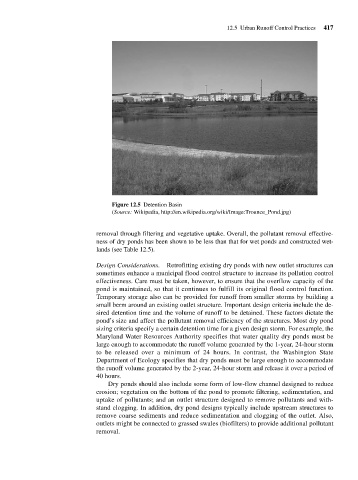Page 459 - Fair, Geyer, and Okun's Water and wastewater engineering : water supply and wastewater removal
P. 459
JWCL344_ch12_398-456.qxd 8/4/10 9:37 PM Page 417
12.5 Urban Runoff Control Practices 417
Figure 12.5 Detention Basin
(Source: Wikipedia, http://en.wikipedia.org/wiki/Image:Trounce_Pond.jpg)
removal through filtering and vegetative uptake. Overall, the pollutant removal effective-
ness of dry ponds has been shown to be less than that for wet ponds and constructed wet-
lands (see Table 12.5).
Design Considerations. Retrofitting existing dry ponds with new outlet structures can
sometimes enhance a municipal flood control structure to increase its pollution control
effectiveness. Care must be taken, however, to ensure that the overflow capacity of the
pond is maintained, so that it continues to fulfill its original flood control function.
Temporary storage also can be provided for runoff from smaller storms by building a
small berm around an existing outlet structure. Important design criteria include the de-
sired detention time and the volume of runoff to be detained. These factors dictate the
pond’s size and affect the pollutant removal efficiency of the structures. Most dry pond
sizing criteria specify a certain detention time for a given design storm. For example, the
Maryland Water Resources Authority specifies that water quality dry ponds must be
large enough to accommodate the runoff volume generated by the 1-year, 24-hour storm
to be released over a minimum of 24 hours. In contrast, the Washington State
Department of Ecology specifies that dry ponds must be large enough to accommodate
the runoff volume generated by the 2-year, 24-hour storm and release it over a period of
40 hours.
Dry ponds should also include some form of low-flow channel designed to reduce
erosion; vegetation on the bottom of the pond to promote filtering, sedimentation, and
uptake of pollutants; and an outlet structure designed to remove pollutants and with-
stand clogging. In addition, dry pond designs typically include upstream structures to
remove coarse sediments and reduce sedimentation and clogging of the outlet. Also,
outlets might be connected to grassed swales (biofilters) to provide additional pollutant
removal.

